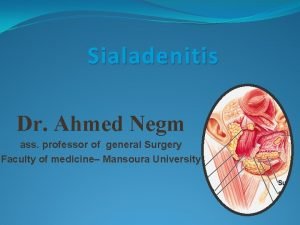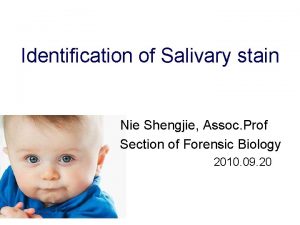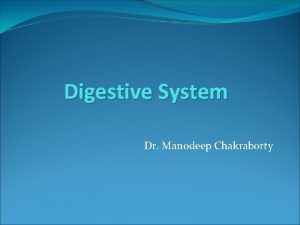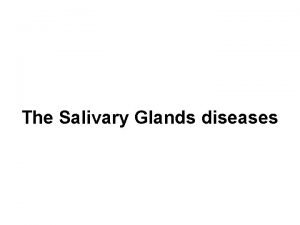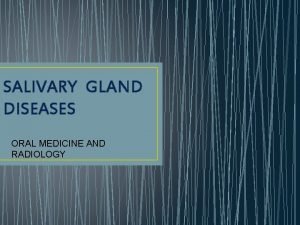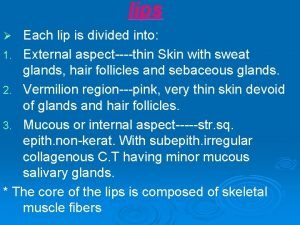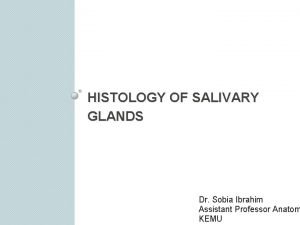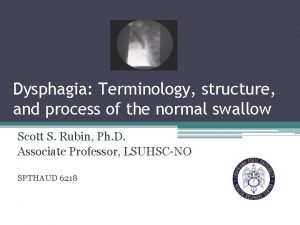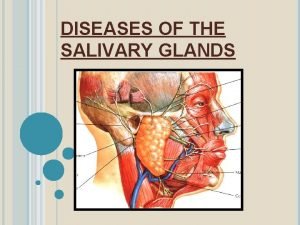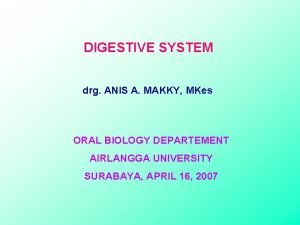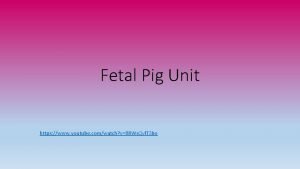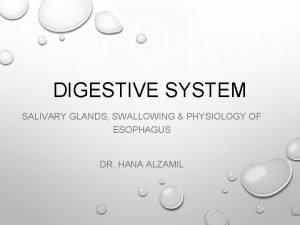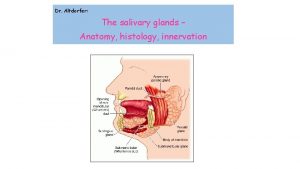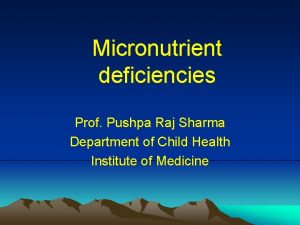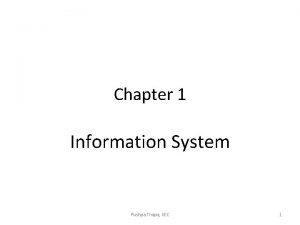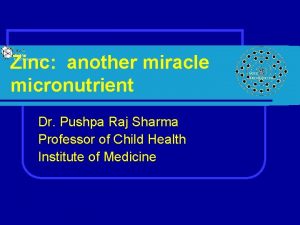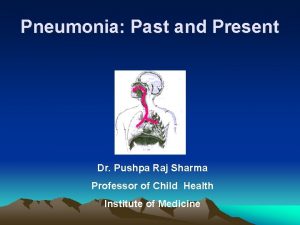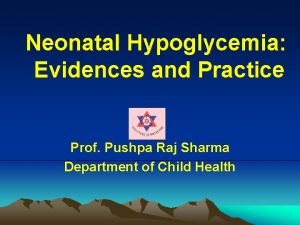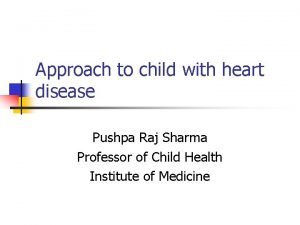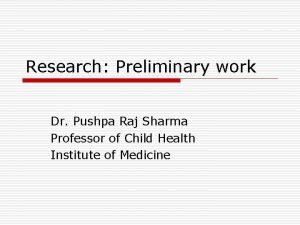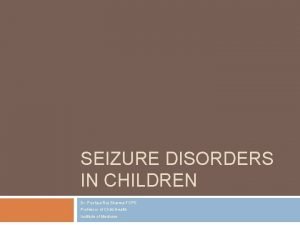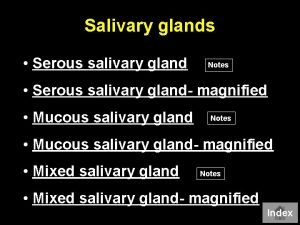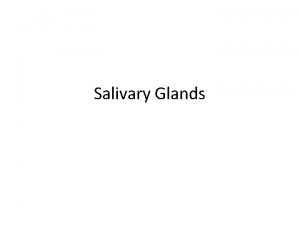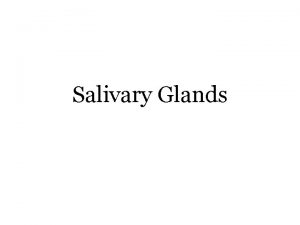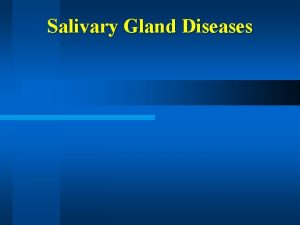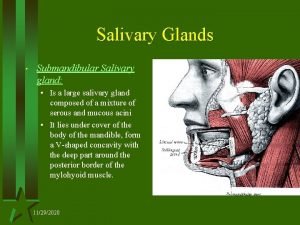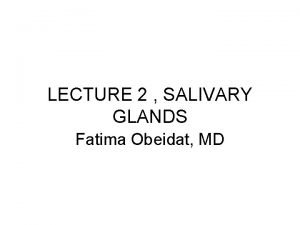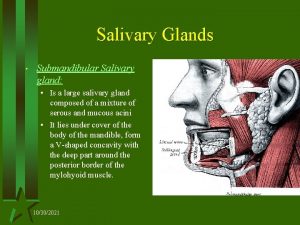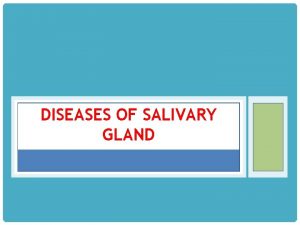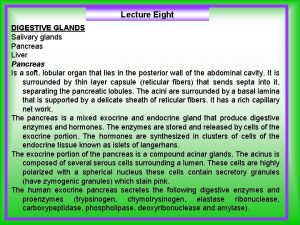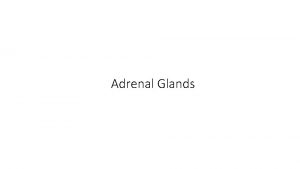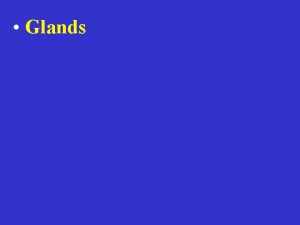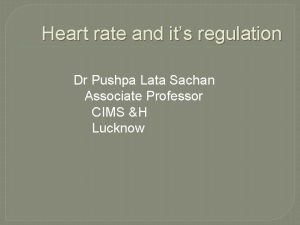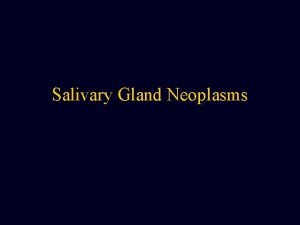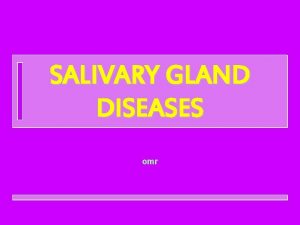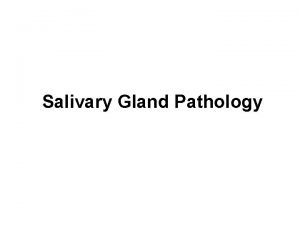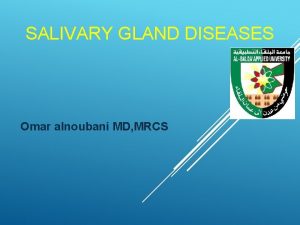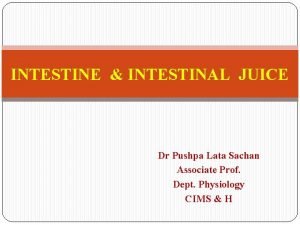Salivary glands and its applied Dr Pushpa Lata
























- Slides: 24

Salivary glands and its’ applied -Dr Pushpa Lata Sachan Associate Prof. Dept. Physiology CIMS & H


These are compound tubuloacinar exocrine glands found in oral cavity that secrete complex fluid known as saliva. CLASSIFICATION OF SALIVARY GLANDS – 1 -Based on size 2 -Based on type of secretory cells

CLASSIFICATION OF SALIVARY GLANDS BASED ON SIZE: 1. Major salivary glands 1. Parotid, 2. Submandibular and 3. Sublingual. 2. Minor salivary glands- Lingual, buccal, labial, palatal glands, glossopalatine and retromolar glands.

CLASSIFICATION OF SALIVARY GLANDS Based on type of secretory cells 1. Serous - Parotid 2. Mixed (seromucous)- Submandibular 3. Mucous- Minor salivary glands.

Composition of salivary Juice: �Daily secretion : - 1000 ml to 1500 ml �PH: - slightly below 7 (6. 35 to 6. 85)- slightly acidic � 99. 5% water � 0. 5% solids: � � � (a)Inorganic sub stances: Na+, k+, Ca+, Hco 3, Cl, So 4, Po 4, etc. (b) Organic- sub stances: -

(b) Organic- substances: �Salivary protein – mucin (glycoprotein) �Enzymes: �Ptyalin, or , salivary- amylase (main Enzyme) �Lingual lipase �Lysozymes (bactericidal) �Blood group antigens. �Ig. A (for defence against bacteria & viruses )

�Enzymes: α- amylase Lysozyme, Lactoperoxidase, Kallikrein, Mucins Lactoferrin and many others. �Immunoglobulins. � Ptylin is an enzyme for digesting starch. �Mucin for lubricating and for surface protective purposes.

Parotid gland �Parotid gland -Largest salivary gland 25% of total saliva. �Stenson’s duct: - runs forward across masseter muscle, turns inwards at the anterior border of masseter and opens at a papilla in the oral cavity just opposite second molar crown. �By stenson’s duct parotid gland secretions reaches to oral cavity.

Submandibular glands �Almost 75% of total saliva secretions by this glands. �Wharton's duct runs forward and opens into the mouth beneath the tongue, lateral to lingual frenum. �Serous secretion -That contains Ptylin. �Parotid glands secrete almost entirely serous type of secretion while submandibular and sublingual glands secrete both serous secretion and mucus. �Buccal glands secrete only mucus.

Functions of Saliva �Oral hygiene � saliva helps prevent the deteriorative processes in several ways. �Protective function-saliva contains lysozyme, which is anti-bacterial. �Ig. A in saliva provides local immunity and lactoferrin in saliva is bacteriostatic. �Saliva keeps the mouth cavity and tongue moist which facilitates speech. �Saliva increases the taste of food �Saliva helps in mastication and swallowing.

�In the absence of saliva , deglutition becomes impossible. �Saliva contain bicarbonate which buffers gastric acid in this way reduces heart burn. �Proline rich protein in saliva protects enamel of teeth and thus provides them strength. �Proline also binds with tannin and reduces the toxicity. �Saliva prevents the injury to buccal mucosa by diluting the hot and irritant food materials.

REGULATION OF SALIVARY SECRETION: �Two varieties of salivary secretion: �SPONTANEOUS SECRETION : - Occurs all the time , without any known stimulus, & -keeps the mouth – moist all the time

� STIMULATED SECRETION: - Occurs After a known stimulus, e. g. �Psychological (thinking of food / sweet) �Visual (looking at delicious food / sweet) �Taste (tasting good food , in the mouth) �Others (if during vomiting) �Stimulated secretion of saliva – is due to reflex salivary reflex – which depends on nerves, supplying salivary glands.

NERVE – SUPPLY TO SALIVARY GLANDS: (a)Para sympathetic N. supply: (i) Parotid S. G. - by ix- N. (Gloss pharyngeal) (ii) sub mandibular & sublingual S. G. – by VII- N. (facial) �Stimulation of sympathetic nervous system – decreases secretions of saliva.

Para Sympathetic – Innervation To Salivary Glands �So, VII-cranial nerve – supplies: - Sub mandibles & Sublingual salivary gland. �& IX Cranial Nerve- Supplies: - Parotid –salivary gland. �Para sympathetic stimulation – increases salivary glands secretion.

Salivary Reflexes Two types of Salivary Reflexes: �UNCONDITIONED – REFLEX : - are in born & present since birth. �Their presence require – no previous experience �E. g. salivary secretion in oral phase �CONDITIONED – REFLEX: - require previous – experience, or training , -are not inborn �e. g. salivary secretion in Cephalic – phase �The reflex was discovered by – Ivan – Pavlov

Mechanism of Salivary Reflex: �(a) -Stimulus (food / sweet) in Cephalic , or oral – Phase �(b) Afferent- limb - reaches to � (c) salivary center (In medulla & lower part of Pons), Nucleus tractus Solitarius To Superior & Inferior Salivary nucleus �(d) Efferent limb – Para sympathetic nerves (VII & IX - N. ) �(e) Salivary glands �(f) Salivary secretion.

APPLIED – ASPECTS: �HYPO SALIVATION : - Decreased salivary secretion �Absence of or deficiency in secretion of saliva -known as -“Aptyalism” – resulting in “xerostomia” or” Dry mouth

�Causes of temporary – hypo salivation: �Dehydration - (e. g. Diarrhoea , Excessive Sweating , etc. ) �Fever �Emotional Conditions like fear, depression etc. �Shock �After Smoking �By some drugs – Avil, Atropine, etc.

Causes of Permanent- Hypo salivation: �“Sialolithiasis”-i. e. obstruction of salivary duct by stone. �Congenital absence , or , hyperplasia of salivary gland – Atyalism. �‘Bell’s – palsy ‘ i. e. paralysis of facial nerve. � Irradiation therapy- in area of salivary glands. �

Hyper salivation � HYPER SALIVATION: - Excess secretion of saliva. �In following Conditions: �Physiological Conditions : �e. g. Pregnancy

HYPER SALIVATION � (b) Pathological Condition: - Also called “Ptyalism ” or Sialorrhea ‘ �e. g. Dental Caries , tooth decay , oral tumor �Disorders of esophagus , stomach & intestine �Nausea & vomiting �Neurological disorders, � e. g. – Cerebral palsy � - Mental retardation � - Cerebral stroke � - parkinsonism

 Salivary gland swelling
Salivary gland swelling Nie wiem association
Nie wiem association Ts of liver
Ts of liver Salivary glands anatomy
Salivary glands anatomy Sialography
Sialography Minor salivary glands
Minor salivary glands Serous demilunes histology
Serous demilunes histology Minor salivary glands
Minor salivary glands Submandibular gland excision
Submandibular gland excision Minor salivary glands
Minor salivary glands Pancreas organ
Pancreas organ Function of salivary glands
Function of salivary glands Serous vs mucous
Serous vs mucous Apocrine secretion
Apocrine secretion Dr pushpa raj sharma pediatrician
Dr pushpa raj sharma pediatrician Humen kec distribution
Humen kec distribution Dr pushpa raj sharma
Dr pushpa raj sharma Pushpa raj sharma
Pushpa raj sharma Dr pushpa raj sharma clinic
Dr pushpa raj sharma clinic Pushpa wood name
Pushpa wood name Dr pushpa raj sharma pediatrician
Dr pushpa raj sharma pediatrician Pushpa x ray
Pushpa x ray Dr pushpa raj sharma
Dr pushpa raj sharma Dr pushpa gross
Dr pushpa gross Pushpa raj sharma
Pushpa raj sharma
